More Myanmar: Shiny happy people

Okay, not a "person", perse, but I swear even the water buffalo of Myanmar smile at you!
Many of the sites of Myanmar were beautiful, but undoubtedly the best part of the country is the people. They are among the kindest, sweetest people in the world - a smile was never far away! Sure, I bumped into a few opportunistic ones who openly asked for money (or pens...), but they were few and far between. On one hand, I know they are so friendly (almost innocently so) because of their wacky (yes, that was meant to be pejorative!) government's reluctance to open them to the wider world. I want this crazy military government to be toppled as much as the next person, but, on the other hand, this would force many them into the cynicism (and blatant opportunism) of the modern world....and I want them to stay as sweet as they have always been! Ah, what to do? I truly believe that, one day, the good people of Myanmar will be afforded the opportunity to enjoy the wider world...and if it means they become assholes...well, I'll deal with that. At least I'll always have memories of the wonderful people (and smiles) from this trip!
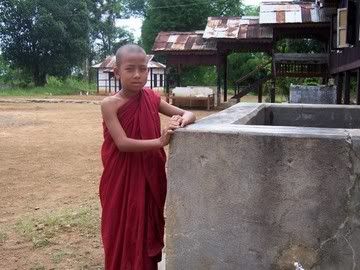
In the predominantly Buddhist culture of Myanmar (over 80% of the people are Buddhist), most boys will become novices (kinda like junior monks) in a local monastery by the time they're 10 years old or so. This is important because only men are technically allowed to interact with senior monks, so the novices learn the basics of the ancient Bali language (for chanting prayers) and eitquette for interacting with monks. What's funny is that the kids actually don't stay monks for very long. Maybe a few weeks during their summer vacation? It's a very interesting thing, though. This little novice was really cute and smiley...except when I took his picture, of course!

Another sweet, smiley kid who I met when my bus broke down in the middle-of-nowhere!

I met this little boy while I was waiting in a teashop for my boat to (somewhere I can't remember!). He was funny...just kept smiling and giggling nervously when I smiled at him. Of course, i had to take a picture!
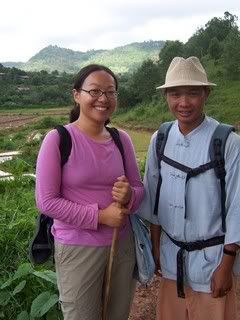
Here I am with one of my favorite people in all of Myanmar: Mr. Tun Ti, my guide during my three-day trek through the Shan countryside. His family runs a trekking company in the town of Kalaw, but they do waaaay more than just lead treks. The family works closely with numerous villages in the region to create responsible and productive tourism. They use a different trekking path each time (so that no one village ever gets too "spoiled" by the foreigners) and never give money to the villages. Instead, they offer their time and services to the villages in exchange for permission to pass through them - that is, offering rides to nearest hospital for sick villagers, finding teachers for local schools, etc. Mr. Tun Ti and his wife even opened their house to kids from remote villages who want to continue their education in Kalaw - without asking for a dime. It's great. Mr. Tun Ti was the best guide! He spoke 5 of the local dialects fluently and knows the region like the back of his hand, so I always got a good insight on village life and culture. The trek was definitely the highlight of my Burmese days, in large part to Mr. Tun Ti.
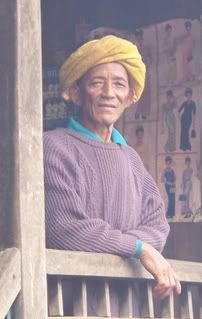
One of the villagers of the Palaung tribe who was so kind to host us in their home for lunch during my trek through the Shan countryside with Mr. Tun Ti.
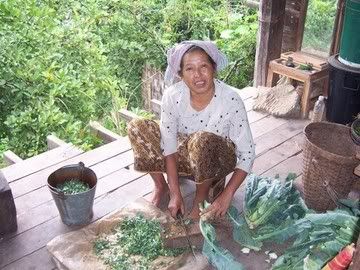
I stayed in this wonderful lady's home during the trek. It was a simple and lovely home, and she and her husband were so nice. Here she is, hard at work prepping vegetables for a later meal.

Captured in one of the villages through which I trekked, this is quite a common scene! You can often catch glimpses of kids riding through the village on their water buffalo, stick in hand and topped off with a topi hat, one of the quainter remnaints of British colonial times. This is one of my favorite pictures of my whole year of traveling.

No paved roads and the existence of only narrow footpaths winding through much of the rice paddies of the Shan province means that most transport takes place by foot. It can take hours to arrive at a main road, where you might be lucky enough to flag down a pick-up truck into town to sell your goods or buy some supplies. Want to carry that stuff? Try the handy basket thingy pictured here! Notice the ever-spiffy topi hat, perfect protection from both the sun and rain.
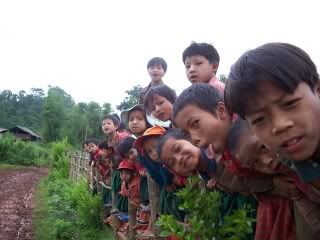
During the trek, we came upon a small rural school, where kids were playing outside for recess. They were a curious group who were a lot a fun! They did not ask for anything, but were really keen about these crazy digital camera gadgets. What a really sweet bunch of kids...apparently good students, too: as soon as the teacher rang her bell, they forgot about us promptly and ran back inside in 2 seconds flat!
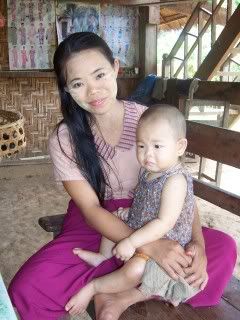
People generally consider women of the Shan tribe to be the most beautiful in Myanmar. Throughout my trip, I kept hearing, "Ah, Shan women! Very beautiful! Hard working, too! Want to take care of their husbands! Very good!" I certainly met quite a few very pretty Shan women, including this lovely lady and her (slightly gloomy but very cute) baby in one of the small villages outside of Hsipaw. Notice the thanaka to protect and moisturize her skin. Like she needs it...yeesh! I argue that famed Shan beauty is particularly pronouced because the Shan people originally came from China. Tee hee.

An adorable little girl whom I played with at Inle Lake. They teach 'em early how to work hard, that's for sure.
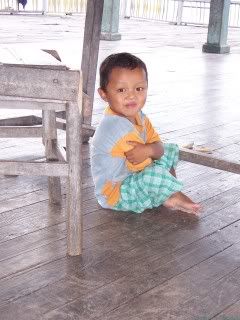
Adorable little brother of above-pictured adorable little girl. He was such a ham! He loved seeing his digital picture pop up on my camera and insisted I take few more. How could I say no?
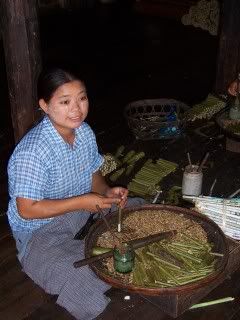
Cheroot are Myanmar cigars filled with a mix of mild tobacco and herbs. They are rolled by hand by girls and young women, like this cheery girl at an Inle Lake cheroot "factory" (i.e., bunch of girls in a room). She treated me to cheroot, and we smoked up together. :)

At one of the Inle Lake markets, I was intrigued by the homegrown and smoked teas sold by some of the hill tribe villagers. This girl actually called out to me (in Burmese) and encouraged me to buy some. Take note: a smile and friendly demeanor can compell me buy just about anything. This girl was really sweet. And a small bag of tea cost a hot 200 kyat (US$0.15).

I waved at a lot of kids while I was in Myanmar. I mean, like, a lot. What I always found really sweet (and a bit funny) was how the moms would always force the most unwilling kid to wave back at me. Well, this little girl wasn't so unwilling, as you see by her lovely smile. She definitely provided my most memorable game of "Make faces at cute kids and have 'em make 'em back at you!" in Myanmar. These kids (and their moms) just kill me!
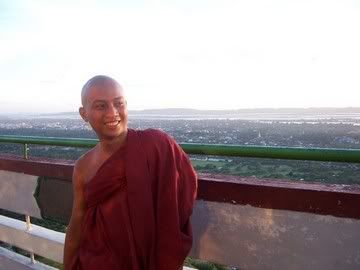
There are so many monks in Myanmar, particularly in Mandalay. On top of Mandalay Hill, I met Shawana. A lot of the monks speak English and go to popular tourist spots to practice with foreigners. Some of them are real monks, others are con artists. Shawana seemed reasonably honest (at least he didn't ask me for money...like some monks I met!), so we chatted a bit. Interesting characters, those monks!
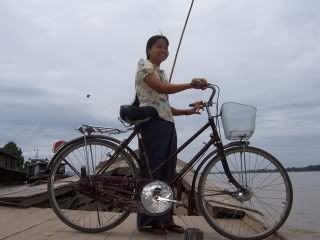
Gosh, I certainly took a lot of random pictures of random people in Myanmar (like this friendly girl who rode the ferry with me in Monywa). What's even more surprising are the number of people who allowed me to take their photo! And always with a smile!
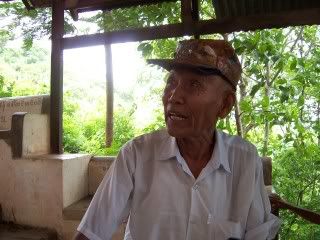
This man randomly bumped into me and a fellow American, Hugh (3rd grade teacher from Colorado), who was traveling with me in Mandalay. He found out that we were Americans and started rattling off happily in English! He was so engrossed in chatting that he didn't even flinch when I took this photo. He spoke really fast and used "man" (as in, "That's good, man!") quite alot, all the while so happy to see that Americans were visiting Myanmar. With his USMC(?) veteran's cap, I began to wonder if he had ever worked with Americans (maybe waaaay back in the day, during World War II or something? That would explain the use of "man", I guess). In any case, he actually thought I was Burmese (mad props to my dark tan at the time) and said that I looked like a sweet girl (in a non-pervy, nice way). Geepers, thanks, mister!

As in much of Southeast Asia, there is a sizeable Chinese population in Myanmar. Many of the larger towns have a very visible Chinese community within each of them. It is surprising how many still know how to speak Chinese (the dialects of their home provinces or variations on Mandarin with funny accents) despite being many generations removed from the Mainland. This was really helpful, as I often resorted to Mandarin when I couldn't find anyone who spoke English...and was rather successful some of the time! I visited the Chinese temple in Pyin U Lwin, where I met this wonderful elderly gentleman, who was thrilled to find out that I was also Chinese. In broken and heavily accented Chinese (regional Yunnan dialect, I think), he explained to me the story of Buddha (drawn on panels in the temple). I asked to take his picture, and he was so cute, buttoning his shirt up all the way to the collar to look "proper" for the photo. At the end, he said something I'll never forget: "You know, you may be from America and I may be from Myanmar, but we're still Chinese! You come back and visit me anytime you like!"
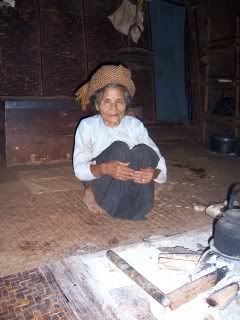
Another favorite in the "YuhChic Loves Senior Citizens of Myanmar!" series. I met this wonderful lady while trekking through the Shan hills. My trekking guide stopped by this lady's house because she (and her son-in-law) are personal friends. At age 76, she is the oldest person in her Pa-Oh village of 300 people . She shared some really interesting bits of village culture with us, recounting stories of the old days (e.g., men used to court women by showing up in front of the woman's house and court them by playing flute music; this tradition still continues, although a bit unromantically by playing the radio instead of a flute) as well as humbly mentioning some of the tougher "facts of life" during our conversation (e.g., 5 of her 9 children died, including a daughter who died from childbirth at age 19). She offered us some rice and beans, so of course I could not refuse! As I ate it, she said, "I hope that you will always remember me when you eat rice and beans." I certainly will!

1 Comments:
I think I met the same old guy on the walk up to Sagaing Hill, he almost demanded that I take a photo of him!
I was there in October so you obviously started a trend!
Post a Comment
<< Home